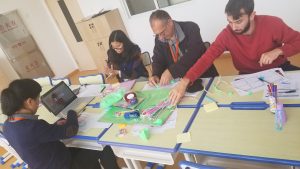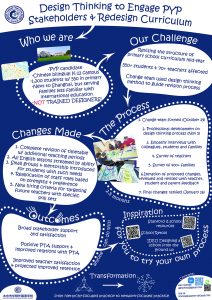This article shares a process of how PYP school administrators and their change team used design thinking to adapt the primary school’s curriculum to stakeholder needs – including students, parents and teachers. The outcome of using this methodology included significant changes to both school culture and curriculum.
Driving school change during PYP candidacy is a complex challenge. It’s even more difficult when the change should be stakeholder-driven but the school has roots in a traditional culture of top-down decision making. As a Chinese candidate school working to embrace agency throughout our learning community, the change from top-down to community-up leadership was a challenge for our team.
We faced a need to make big changes when, as a candidate school, we received our consultant’s feedback that we likely wouldn’t succeed in PYP authorisation unless we changed our language of instruction from English to Mandarin Chinese. This suggestion made sense for the way the school’s demographics were changing and so the school committed to make the change to better serve our students and families. But changing our language of instruction also meant broad curriculum changes in the middle of the school year for more than 550 students and families and more than 70 teachers. It was certainly daunting, especially because we wanted to honour and engage community voice and ownership in driving the change. Fortunately, we found a process that allowed us to do this and accelerated the change process when we chose to apply a design thinking approach that focused on our community needs.
We initiated the process by building a change team made up of stakeholders representing a variety of perspectives, interests and levels of authority. The team included teachers and various levels of administration from both local and international backgrounds. We felt our team was well-composed. However, a good team alone would not be enough to drive change in our context.
Top-down cultures create a deference to authority that can strongly orient team members towards thinking about what their bosses want or what they believe their bosses would accept rather than thinking about what students, families and other community members need. As a Chinese school going through the transition to the IB, our campus certainly had some vestiges of this top-down culture. Our change team would need to overcome this top-down culture if we wanted a stakeholder-driven solution to our curriculum challenge. Using a design thinking approach for the team seemed to make sense because it was all about development and design driven by end user needs.
With our change team formed, we came together to do some professional development on design thinking processes. We used resources from Stanford’s d.school and Harvard’s Graduate School of Education and got right into hands-on practice: designing an ideal tool belt for a partner. Although seemingly simple, this exercise clarified the fundamental importance of using empathy to understand the user’s problem, creativity in brainstorming solutions and critical thinking through the process of testing and refining solutions. At the end, change team members had built fun and silly prototype solutions to meet their partner’s needs. More importantly, in the process we had quickly picked up the fundamentals of how we needed to work as a team designing for our community.
The next step was about getting real. We needed to find out what the real needs of our stakeholders were, including parents and students and local and international teachers. We divided this work up and dove into it with surveys and empathy interviews. We pulled in data from parents, teachers and students and compiled a data set reflecting the interests and priorities of hundreds of members of our school community.
With the data now in hand, our change team met again to share what we had learned. It was time to think as designers, imagining what changes the school could enact that would meet the real needs of our diverse group of users. Finding a balance with so many different stakeholders was certainly tricky. At first, it felt like we had opened a can of worms and found many more problems to deal with than we had initially expected, but we kept faith in the process, designed solution proposals and took these proposals back to our colleagues, students and families for some user feedback.
Critically, although we were already moving forward with testing solutions, the process we were following didn’t have anyone thinking about supervisor approval. Instead, everyone was focused on the real community needs.
Finally, after two months going through cycles of adjusting plans, seeing how teachers, students and parents would feel about them and refining designs, we were confident we had a plan to make everyone happy. The changes now included broad restructuring of classes, supporting students of different ability in English lessons, creating new small group classes and mentorship classes, reallocating teacher roles based on preference and abilities and even developing new hiring criteria for future teachers – changes that would affect every student, teacher and family in the primary.
These changes were certainly dramatic, but there was no need to ask for approval, because the process had developed a plan that already had everyone on-board. By keeping our focus on stakeholder needs we had found a solution that seemed to make everyone happy and had everyone buy-in.
With support of our PTA, we implemented our changes at mid-year. The feedback has so far been strongly positive across the board. We overcame the challenge of how to adapt our curriculum, we solved some unanticipated problems our stakeholders were dealing with and, maybe most importantly, we moved the school’s culture away from top-down hierarchy towards community-up decision making.
It was a gratifying process and a great learning experience for our leadership team.
Finally, I feel it must be emphasized that our team were NOT trained designers prior to going through this process. We had some good guidance and resources from helpers in Harvard’s Graduate School of Education, but I fundamentally believe that any leadership team can learn to do what we did. The key ingredients are courage, empathy, communication, critical thinking and collaboration.
References:
Harvard Graduate School of Education. (n.d.). Leading Learning Module, Week 5-7 Block 2: Design Thinking. In Certificate in Advanced Educational Leadership: Fall 2018. Retrieved from: https://exed.canvas.harvard.edu/courses/800/pages/weeks-5-7-application-block-2
Platner, Hasso. “An Introduction to Design Thinking” Institute of Design at Stanford. (n.d.) Retrieved from: https://exed.canvas.harvard.edu/courses/800/pages/weeks-5-7-application-block-2
________________________________________________________________
Alex Makosz has been involved in studying and leading school change processes in China for over ten years. Currently serving as Director – Curriculum, Assessment & Learning for the Chiway Education Group and Vice Principal at Taicang Walton Foreign Language School. You can connect with Alex via LinkedIn at https://www.linkedin.com/in/alexmakosz/ or on Twitter @agmakosz.
________________________________________________________________




No comments yet.